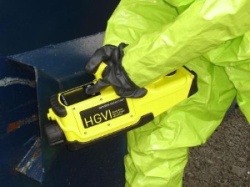May 27 2010
A Central Command Center’s emergency responders will now be able to see and evaluate chemical sensor data in real time from the installed handheld vapor and gas identifier units by using a pioneering software system known as HGVI LINX that was recently introduced by Smiths Detection. HGVI stands for ‘Handheld Gas & Vapor Identifier.’
 Smiths Detection's HGVI LINX features advanced software that enables real-time data feeds transmitted out of danger zones.
Smiths Detection's HGVI LINX features advanced software that enables real-time data feeds transmitted out of danger zones.
The HGVI LINX will be showcased during May 19-23, 2010, at the International Association of Fire Chiefs Conference in Baltimore, Md.
The company provides enhanced security systems for military and civil markets world over and develops and produces government-regulated products for identifying explosives, weapons, contraband, biological and chemical agents. It is a division of Smiths Group that is a global supplier of state-of-the-art technologies to markets dealing with threat, detection of contraband, communication, engineering components, medical devices and energy.
The HGVI will be able to detect, identify, and quantify chemical warfare agents (CWAs) as well as toxic industrial chemicals (TICs). This software features novel enhanced algorithms, RF transmission technology and GPS functionality, which improves the capability of the system. It can display a maximum of 16 HGVI units’ data readings at the same time. These live readings, along with system status and detailed alarm information, can be displayed through one command center computer that is installed a kilometer away from an incident. Such information is superimposed automatically on preloaded building diagrams or geographical maps as per user requirement.
Smiths Detection’s Global Military & Emergency Responder business unit’s Senior Product Manager Ken Fredeen informed that communication speed is vital in the event of a chemical threat emergency since the containment of vapors and gases is difficult. He explained that HGVI LINX utilizes the new generation remote monitoring technology for speeding up the communication and emergency response to a command center. He added that emergency response units will be able to track results using the HGVI LINX from outside a hot zone for enhancing their capability for tracking airborne threats that are time critical.
Smiths Detection’s Americas Military & Emergency Responder business unit’s Vice President Tim Picciotti added that the new software is a landmark for Smiths Detection and is considered as another step to an integrated solution. He said that it will enhance and simplify the way in which emergency responders are able to relay and communicate information and at the same time result in the technology’s increased utilization.